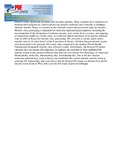| dc.description.abstract | Measles causes significant morbidity and mortality globally. Many countries have embarked on immunization programs to control and prevent measles outbreaks and eventually to eliminate endemic measles. Kenya is currently in the outbreak control and prevention stage for measles. Measles virus genotyping is important for molecular epidemiological purposes, including the documentation of the elimination of endemic measles virus strains from a country, and mapping of transmission pathways. In this study, we collected clinical specimens from measles outbreak cases in 2002 in Kenya for measles virus genotyping. We were able to isolate and/or detect measles virus in 10 cases from 5 of the 8 provinces in Kenya. All these Kenyan measles strains were determined to be genotype D4 strains when compared to the standard World Health Organization-designated measles virus reference strains. Interestingly, the Kenyan D4 strains clustered into two distinct D4 subgroups. In addition, the inclusion of other published D4 measles strains in this analysis indicated that there are four distinct D4 clusterings, or subgroups: Montreal-like, India-like, Johannesburg-like, and Ethiopia-like. This is the first measles molecular epidemiology study in Kenya and establishes the current endemic measles strain as genotype D4. Importantly, this study shows that the Kenyan D4 strains are distinct from the B3 measles strain found in West Africa and the D4 strains reported in Ethiopia. | en |

